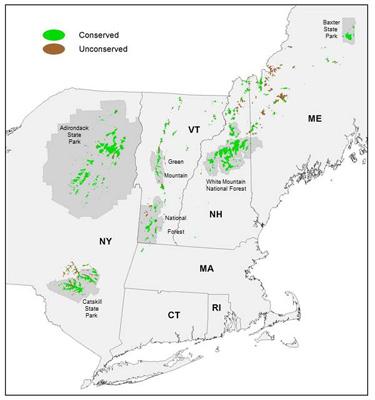High-elevation Spruce-Fir Forest in the Northern Forest: An Assessment of Ecological Value and Conservation Priorities

High-elevation areas are a limited yet critical component of the Northern Forest. They provide habitat for Bicknell’s thrush, the Northeast’s rarest migratory songbird, and other species of conservation concern. They are also likely to provide refugia for spruce-fir-dependent species in a future warmer climate. These areas have been a target for wind power development, but inappropriately sited wind power projects threaten to degrade this critical habitat.
NSRC researchers assessed the extent, conservation status, development and harvest history, and ecological value of high-elevation areas (>2700 feet) across the Northeast. Ecological values include elevation range; extent of spruce-fir and subalpine forest; presence of rare plants, natural communities, and Bicknell’s thrush; extent of potential thrush habitat; large roadless areas; and identification as priority in state wildlife action plans. This information is presented in a Google Earth application (http://www.outdoors.org/conservation/wind/wind-research.cfm).
Researchers delineated 766,000 acres of high-elevation land or about 1.2% of the five-state area. Level of conservation is high relative to other parts of the landscape, with over 83% of high-elevation land under permanent conservation. Maine is the exception with less than half of its high-elevation land conserved. The greatest extent of unconserved high-elevation land is the northern Boundary Mountains of western Maine. To date, 10 wind power projects have been constructed, permitted, proposed or are under development in high-elevation areas, with 3 (one operating, one permitted, and one denied) in areas of rare subalpine forest habitat occupied by Bicknell’s thrush. Information developed in this study will guide future conservation of high value areas and promote appropriate siting of commercial wind power development.
